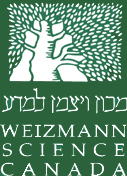|


The Weizmann Institute of Science, founded in 1934, is a community of 2,500 scientists, scientists-in-training and engineers engaged in a full agenda of 1,000 research projects ranging from basic medical research to chemistry, biology, agriculture, computer science, environmental studies and the fundamental laws of physics. All share the goal of enriching life on earth.
To read about the most recent breakthroughs, CLICK HERE
If you would like to be among the first to hear about the latest achievements at the Weizmann Institute of Science, please take a moment to register for our email updates.
CANCER
 |
• Science tips 38.pdf
Alternative enrgy-9.06.pdf
More than 153,000 Canadians are newly diagnosed with cancer each year. Cancer claims the lives of over 70,000 Canadians annually and is the leading cause of premature death in Canada. In response to these startling statistics, more than 50 percent of all research in life sciences at the Weizmann Institute of Science is cancer-related.
|
• Weizmann scientists were among the first to study and clone the p53 gene, associated with most malignant tumors in humans. They determined that this gene can suppress cell proliferation and instigate necessary cell death. New treatments based on these findings are being developed.
• A Weizmann scientist tackled the problem of bone marrow transplantation between incompatible donors by using a hormone to mobilize bone marrow cells of leukemia patients and “bubble” children.
• Weizmann scientists are developing a blood test to uncover risk for lung cancer, the leading cancer killer.
• Weizmann scientists pioneered the use of MRI as a non-invasive means of diagnosing cancer. An Institute-developed method called Three Time Point (3TP), approved by the FDA, uses MRI to detect malignant tumors without biopsies.
• Weizmann scientists are conducting pioneering research on the viability of photodynamic therapy (PDT) to treat malignant tumors. PDT uses a non-toxic drug that is injected into the bloodstream or directly into the tumor. Clinical testing is underway.
• Weizmann research provided the foundation for the development of the drug Gleevec®, approved by the FDA, to treat chronic myelogenous leukemia.
• Weizmann scientists succeeded in reversing the metastatic properties of colon cancer; their research may be used as the foundation for drugs that can specifically target colon cancer-causing genes.
• A chemical found in garlic has been used by Weizmann researchers to destroy malignant tumors in mice while leaving healthy tissue intact. The scientists developed a two-step system for delivering the cancer-wrecking chemical straight to the tumor cells. The technique could prove invaluable for preventing metastasis following surgery.
TECHNOLOGY
• In 1954, Weizmann scientists built WEIZAC, the first computer in Israel and one of the first in the world, laying the groundwork for Israel’s high-tech economy, often referred to as the second Silicon Valley.
• A Weizmann computer scientist created a computer language called Statecharts that facilitates the development of sophisticated systems such as those used in aircraft, space shuttles, and nuclear power stations.
• A Weizmann scientist developed several methods with colleagues from overseas for encrypting and decrypting information. This research led to the development of “smart cards” that limit satellite broadcast reception to paid subscribers. The encryption technology is also used in financial and governmental communications worldwide.
• Weizmann scientists developed a method of laser cutting diamonds that reduces the loss of material and cuts stones into virtually any shape.
• Sunglasses and vehicle windshields that darken when bright light falls on them are familiar consumer goods that were developed following the discovery of photochromism in a Weizmann lab.
• Lasers that control chemical reactions were developed by Weizmann scientists with colleagues over-seas. This finding may lead to a new way of isolating molecules for new drug development.
• The Weizmann Institute was the first academic institution in Israel to create a technology transfer organization, Yeda, for promoting the commercialization of its research.
• Weizmann scientists are using brain research to develop advanced robotic visual systems. In addition, human arm motion studies are helping design artificial limbs.
• Weizmann scientists are working on a biological computer—built from DNA—that is so tiny that a trillion of them can fit in a test tube and perform a billion operations per second.
• Weizmann scientists applied for nearly 750 patents over the last ten years.
|  |
ENVIRONMENT
• The World Health Organization puts hunger number one on the list of the top health risks. Agricultural research at Weizmann is helping to feed the world.
• Weizmann scientists developed new wheat varieties that provide nearly a 40 percent higher yield, allowing for greater wheat production per growing area unit. These varieties produce better crops that are more resistant to diseases and natural damage.
• Weizmann scientists were the first to produce hybrid cucumber seeds without hand pollination. This method is used today throughout the world.
• Ninety-seven percent of the Earth’s water supply is too salty for drinking or irrigation. Weizmann researchers are developing efficient consumption and management methods to face this challenge.
• Institute scientists developed a novel solution to the problem of parasitic weeds that ravage crops worldwide, particularly in Africa. An estimated 100 million farmers lose half their yield to these parasites, and the livelihood of 300 million people is adversely affected.
• The Institute is equipped with one of the world’s most advanced solar research facilities, enabling scientists to develop new ways to use the sun’s energy.
• Weizmann scientists are developing a formula to improve rain prediction with great accuracy; information that will be helpful to countries in arid regions.
• Other Weizmann research projects on climate change, including global warming, are aimed at preventing ecological disasters and designing new environmental policies.
• Weizmann scientists discovered a gene in wild tomato plants that provides resistance against disease. The presence of this gene may greatly decrease the need for spraying crops
|  |
with pesticides or treating soil, which can cause environmental damage.
HEALTH
 |
• Copaxone® and Rebif®, two FDA-approved multiple sclerosis drugs, were developed based on Weizmann research. MS affects 2.5 million people worldwide.
• Copaxone® is being investigated for use in treating glaucoma, which affects more than 250,000 Canadians and 67 million people worldwide, 6.6 million of which are blind from this eye disease.
|
• Phase II clinical trials are underway for a treatment developed at Weizmann to regenerate damaged nerves in the spinal cord following serious injury.
• A Weizmann scientist developed a blood test to screen for schizophrenia. The mental disorder, which affects more than two million Americans, now is diagnosed only through behavioral methods.
• Research on stem cells by a Weizmann scientist yielded the creation of human kidneys in mice. This development offers hope for patients suffering from organ failure. Of the 4,000 Canadians awaiting organ donations annually, close to 3,000 of them need a kidney transplant.
• Weizmann scientists pioneered the use of amniotic fluid for prenatal diagnosis, leading to the clinical application of amniocentesis.
• Weizmann scientists discovered that stem cells in the bone marrow can transform into liver cells and help repair a damaged liver. The findings could be a boon to liver repair, the second most sought organ for transplantation in Canada.
• Weizmann scientists discovered the structure of AChE (a brain enzyme). Their research is helping pave the way for the design of anti-Alzheimer’s drugs.
|
|








